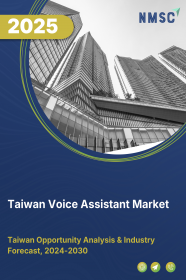
Asia-Pacific Voice Assistant Market by Offering (Hardware (Mobile Device, Smart Speaker, In-Vehicle Assistance, & Other Devices), Software (Integrated, & Standalone), and Services (Support & Maintenance, & Consulting)), by Device (Mobile, PC/Laptop, & Tablet), by Technology (Speech Recognition, & Voice Recognition), by Age Group (Millennials, Generation Z, Generation X, & Baby Boomers), and by Application (Telecom, and Others) – Regional Opportunity Analysis and Industry Forecast, 2025–2030
Industry: ICT & Media | Publish Date: 17-Jun-2025 | No of Pages: 334 | No. of Tables: 265 | No. of Figures: 150 | Format: PDF | Report Code : IC3374
Industry Overview
The Asia-Pacific Voice Assistant Market size was valued at USD 2170.29 million in 2024, and is predicted to reach USD 11120.77 million by 2030, at a CAGR of 31.30% from 2025 to 2030. The significant rise in smart home systems and innovation spurred by leaders in the industry, the market is indeed setting the pace now.
Technological advancements, growing internet and smartphone penetration that is fueling the voice assistant market development in Asia-Pacific region. Also, growth in e-commerce, usage of smartphones and demand for hand-free solutions drive the industry further.
Nevertheless, regulatory restrictions on data privacy hinders the market expansion. With the inclusion of hyper-personalized services in virtual assistant devices creates future growth opportunities for the market.
Technological Innovations and IoT Adoption Drives the Asia-Pacific Voice Assistant Market Growth
Voice assistants turned into mainstream devices for a combination of activities that are carried over to e-commerce, car, and smart homes. Attaining technology innovations, translate into increasing virtual assistant uptake in the APAC region.
Innovations made in natural language processing, voice recognition, and artificial intelligence recently are simplifying the means of communication, with the products promising to be even more convenient in the region.
Increasing Trend for Online Shopping and Hands-Free Solutions is Propelling the Market Growth
The surge in internet buys, smart phone usage, and the demands of having more convenient hands-free methods spurred business growth because nowadays, buyers desire to enjoy an effortless, carefree relationship with the units.
Additionally, due to voice assist technology inclusion inside the car, newer car innovations are enhancing auto navigation systems as well as automotive entertainment in automobiles, so increasing the amount of potential space to grow for the Asia-Pacific voice assistant trends as well.
Regulatory Constraints on Data Privacy and Language Identification Hinders the Market Growth
Data protection and content filtering regulation and language recognition hinder the Asia-Pacific voice assistant expansion. And language diversity and dialect differences throughout the region pose obstacles to precise voice recognition, lowering the effectiveness and usage of voice-enabled healthcare technologies.
Hyper-Personalized Services Propelling Future Opportunities for Growth
The adoption of hyper-personalization services creates future Asia-Pacific voice assistant market opportunities. With the emergence of voice-assisted technology, people are getting personal experiences according to their individual preferences, behavior, and context. This smart technology uses the database for processing information about users so that it gives them personalized recommendations, proactive reminders, or even responses that are contextually aware, that prove to improve user engagement and satisfaction.
For example, in January 2025, SoundHound AI and Lucid Motors partnered in bringing forth the Lucid Assistant-a virtual assistant that touts hands-free, car experiences made easy. With the examination of a wake-up talking phrase such as, hey Lucid, it is possible to communicate with the car in natural language by drivers and passengers.
Hyper-personalization allows voice command technology to suggest playlists according to listening behavior, automate trivial chores as ordering groceries based on previous purchases, or offer tailored fitness advice based on personalized health targets.
The ability to meet customized demands by users makes hyper-personalized virtual assistants the solutions to go for in fields that range from smart homes to healthcare and retailing-hence accelerating growth in the industries for the future.
China Dominates the Asia-Pacific Voice Assistant Market Share
Rapid advancements in conversational AI by major companies are changing how people interact with machines, helping the market grow. These smart assistants allow users to set reminders, control smart home devices, access information, and make hands-free calls.
For example, in November 2024, Samsung launched a new version of its Bixby voice-enabled assistant in China, with improved natural speech recognition, language processing, and behavior-based suggestions. As these assistants become more accurate and personalized, they are becoming easier and more enjoyable to use, that is driving growth and boosting the Asia-Pacific voice assistant market demand.
Moreover, in-car voice assistants drive market expansion with hands-free operation, enhancing driver safety, and enhanced in-car entertainment and navigation. For example, in September 2024, the Chinese electric vehicle maker NIO unveiled an artificial intelligence-powered personal voice assistant, enabling passengers to write messages, make calls, and control vehicle functions.
As additional evidence, recently this month, Cerence-a leading AI-powered voice technology provider-stated that Beijing Electric Vehicle selected its Intelligent Voice solution to enhance the in-car experience of EV customers. The increased interest in voice-enabled assistant systems integration is driving growth in the autonomous and connected vehicle markets, accelerating China's automobile industry development.
India to Witness Substantial Growth in the Asia-Pacific Market
Growing adoption of smartphone penetration in the country is increasing demand for voice-assisted and hand-free interfaces, in return, accelerates the market expansion. Voice aids such as Siri, Google Assistant, and Alexa being built into smartphones provide consumers with easy hand-free functionality for navigating the phone.
India smartphone market is worth USD 44.15 billion in 2023, as per the Ministry of Commerce and Industry report, and is expected to grow to USD 88.99 billion by 2032. With smartphone users looking for more efficient and convenient methods of interacting with their phones, voice assistants are now a necessary feature, boosting its demand in the nation.
Moreover, the voice assistant technology improves user experience in order to better comprehend and interact with user questions that consequently boosts its usage in the nation. For instance, in January 2025, Amazon introduced a new smart speaker, the Echo Spot, in India users control devices at home, play music, alarm, and more.
Also in September 2024, Tata Motors launched a multilingual virtual assistant to upgrade the driving experience in rural India. The new product launch feature allows users to use different features such as navigation, music, and controls of their car remotely with the help of voice commands. All these advancements are driving the industry, as people more and more are using these solutions for convenient and hands-free interactions.
Competitive Landscape
The promising players operating in the Asia-Pacific voice assistant industry includes Amazon Inc, Meta Platforms, Inc, Microsoft Corporation, Apple Inc, IBM Corporation, Samsung Electronics, Alibaba Group Holding Limited, Orange SA, Verint Systems Inc, OpenAI, Swann Security, Xiaomi Corporation, Zirtual, Nokia Corporations, PolyAI Ltd., Hyperlink InfoSystem, Nuance Communications, SoundHound AI, Mihup.ai, Happyrobot, Bitonic Technology Labs Inc, Script Inc., Aiello AI Inc., VoiceKitt, RowBotAI, CE Info Systems Ltd., Mind-r.ai, Alphabet Inc, Continental AG, and German Autolabs.
Asia-Pacific Voice Assistant Market Key Segments
By Offering
-
Hardware
-
Mobile Device
-
Smart Speaker
-
In-Vehicle Assistance
-
Headphones
-
Other Device
-
-
Software
-
Integrated
-
Standalone
-
-
Service
-
Support & Maintenance
-
Consulting
-
By Device
-
Mobile
-
PC/Laptop
-
Tablet
By Technology
-
Speech Recognition
-
Voice Recognition
By Age Group
-
Millennials
-
Generation Z
-
Generation X
-
Baby Boomers
By Application
-
Telecom
-
Smart Home
-
Entertainment
-
Financial Services
-
Retail
-
Transportation
-
Hospitality
-
QSR/Restaurants
By Country
-
China
-
Japan
-
India
-
South Korea
-
Australia
-
Indonesia
-
Singapore
-
Taiwan
-
Thailand
-
Rest of Asia-Pacific
Key Players
-
Amazon Inc
-
Meta Platforms, Inc
-
Microsoft Corporation
-
Apple Inc
-
IBM Corporation
-
Samsung Electronics
-
Alibaba Group Holding Limited
-
Orange SA
-
Verint Systems Inc
-
OpenAI
-
Swann Security
-
Xiaomi Corporation
-
Zirtual
-
Nokia Corporations
-
PolyAI Ltd.
-
Hyperlink InfoSystem
-
Nuance Communications
-
SoundHound AI
-
Mihup.ai
-
Happyrobot
-
Bitonic Technology Labs Inc
-
Script Inc.
-
Aiello AI Inc.
-
VoiceKitt
-
RowBotAI
-
CE Info Systems Ltd.
-
Mind-r.ai
-
Alphabet Inc
-
Continental AG
-
German Autolabs
REPORT SCOPE AND SEGMENTATION:
|
Parameters |
Details |
|
Market Size Value in 2024 |
USD 2170.29 million |
|
Revenue Forecast in 2030 |
USD 11120.77 million |
|
Value Growth Rate |
CAGR of 31.30% from 2024 to 2030 |
|
Analysis Period |
2024–2030 |
|
Base Year Considered |
2024 |
|
Forecast Period |
2025–2030 |
|
Market Size Estimation |
Million (USD) |
|
Growth Factors |
|
|
Companies Profiled |
30 |
|
Countries Covered |
9 |
|
Customization Scope |
Free customization (equivalent up to 80 working hours of analysts) after purchase. Addition or alteration to country, regional, and segment scope. |
|
Pricing and Purchase Options |
Avail customized purchase options to meet your exact research needs. |

















 Speak to Our Analyst
Speak to Our Analyst

























